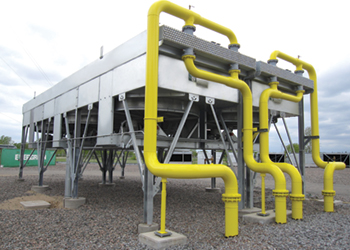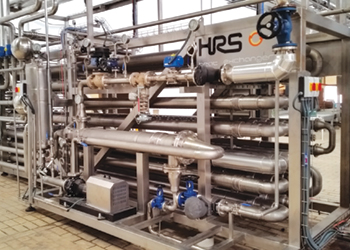
 Air-cooled heat exchangers
Air-cooled heat exchangers
Cooling towers are specialised heat exchangers that reduce the temperature of water by bringing it in contact with air. Water, which has been heated by an industrial process, is pumped to the cooling tower through pipes
Heavy industrial applications such as manufacturing, chemical processing, and oil and gas refining utilise cooling towers and other equipment to cool the water integral to their operations. As environmental regulations and challenging market conditions place higher demands on these industries, improved cooling technologies are emerging to help address these challenges.
In the oil and gas industry, many cooling towers currently in service were built as part of the original refinery construction and are fast approaching the end of their service lives. In order to meet today’s production demands and industry requirements, these towers must be upgraded or replaced with more efficient products and better long-term maintenance plans must be instituted.
COOLING TOWER OPERATION AND TYPES
Cooling towers are specialised heat exchangers that reduce the temperature of water by bringing it in contact with air. Water, which has been heated by an industrial process, is pumped to the cooling tower through pipes. The water sprays through nozzles onto banks of heat transfer material called "fill," which slows the flow of water through the cooling tower, and exposes as much water surface area as possible for maximum air-water contact. As the water flows through the cooling tower, it is exposed to air, which is being pulled through the tower by an electric motor-driven fan.
When the water and air meet, a small amount of water is evaporated, creating a cooling action. The cooled water is then pumped back to the process equipment where it absorbs heat. It will then be pumped back to the cooling tower to be cooled once again.
Different types of cooling towers are suited for different industrial cooling needs. Field-erected towers (FEP) are constructed on site, designed for large heat loads, and are engineered to address the specific application. FEP towers are well-suited for power and heavy industrial uses, and are frequently found in refineries and chemical processing plants.
Factory-assembled towers (FAP) are constructed in modules at a manufacturing facility and then shipped to the processing plant in as few pieces as possible for final assembly. FAP towers are available in a range of cooling capacities and box sizes and include standardised mechanical and structural components.
In order to meet today’s production demands and Oil and Gas industry requirements, many older cooling towers constructed of wood must be upgraded or replaced with more efficient products.
For refineries and chemical processing plants, open circuit wet cooling towers, coupled with shell and tube or plate and frame heat exchangers, provide an economical method for rejecting heat. These towers are designed to wet bulb temperature and can cool water to a lower temperature than some other technologies. But, refineries and processing plants also employ other methods to achieve cooling.
AIR COOLED HEAT EXCHANGERS (ACHE)
Evaporative cooling towers described above use heat transfer fill to effectively distribute the hot process water and increase its surface area for more efficient cooling. The tradeoff is that many fill types require relatively clean water to run effectively. Lower quality water containing particles and debris will clog the fill and reduce performance.
For situations where water is scarce, unavailable or expensive, ACHEs are an alternative cooling technology. ACHEs are built to handle the high heat loads common in oil and gas and chemical processes, require infrequent maintenance and do not evaporate water for cooling.
Air cooled heat exchangers (ACHE) use only air flow to cool hydrocarbon products and other fluids in tubes. Hot process fluid from the plant flows through fin tubes while cooling air flows across them. ACHE work well for higher temperature hydrocarbon applications. These heat exchangers are employed by oil and gas industry because no water or water chemistry maintenance is required and they do not create the vapor plume of evaporative towers. However, they cannot cool water or process fluids to temperatures as low as wet cooling towers since they are designed to dry bulb temperature.
Other specialised heat exchangers, including evaporative condensers and closed circuit fluid coolers are also employed to cool processes and fluids throughout chemical plants.
For situations where water is scarce, unavailable or expensive, air cooled heat exchangers (ACHE) are an alternative cooling technology. ACHEs are built to handle the high heat loads of oil and gas and chemical processes, require infrequent maintenance and use no water.
CHALLENGES FOR OIL AND GAS
In oil and gas refineries, industrial equipment is often jacketed or sleeved with flowing water to cool fluids and absorb process heat. This equipment generates a very large heat load that can disrupt operations if not properly handled. Cooling towers are used to cool this process water for reuse. The towers must not only be able to handle the heat load, but also handle problems unique to the industry. Leaks in the process can cause hydrocarbons to contaminate the cooling water and vice versa. Lower quality, non-potable water is often used to cool plant processes. Meeting environmental regulations limiting hydrocarbons, water usage and drift rates present challenges to plant operators. New industry regulations often require cooling towers to lower the drift rate to 0.0005 per cent of circulating water flow, which can be difficult to achieve in older evaporative cooling towers. Many cooling towers currently in use are not equipped to handle these demands.
A few decades ago, field-erected towers commonly used wood structural members. These cooling towers are coming to the end of their service lives, experiencing mechanical failures, requiring frequent unplanned maintenance that interferes with production and impacting facility productivity. The heat transfer fill in the towers also degrades over time, getting plugged with waste from dirty cooling water and breaking down from the weight of debris.
A good portion of the industry is in need of new towers and better long-term maintenance plans. "A lot of the existing cooling towers are either aging out or suffering from lack of proper maintenance," says Alan Christian, president of Christian Power Equipment, Inc., a company that specialises in equipment for power, process and pollution control. "It’s significant enough that I would call it a trend [in the industry]."
REPLACING OLD TOWERS
Replacing aging wooden cooling towers is a challenging undertaking. Because they are integral to the production process, maintenance, repair and replacement must be accomplished within short scheduled outage periods. Some replacements are done one cooling cell at a time, allowing the plant to continue to operate – a practice known as "on-line construction." Rental of temporary cooling equipment is often necessary. In order to combat replacement logistical challenges and high costs, cooling tower manufacturers offer a range of technology solutions in both FEP and FAP towers. Refineries and chemical plants can replace old, deteriorating towers with modular field-erected towers or pre-assembled package towers that are project and site specific.
"A lot of these refineries were established between 1950 and 1970 when the original towers went in. They built up the refineries around [the towers]," says Pam McLaughlin, sales engineer at Hastik-Baymont, Inc., a company that specialises in engineered equipment solutions for the oil and gas and process industries. "Most places, unless they’re new grassroots refineries, don’t have a whole lot of lay down area to do tower repairs or replacements on a basin that’s already erected. There’s just not a lot of available space."
To work with these constraints, SPX Cooling Technologies has modularised the production and field assembly processes for counterflow FEP towers. The modular Marley F400 Cooling Tower, for example, erects faster and requires less site lay-down area compared to traditional tower construction methods while offering the same powerful capabilities to keep up with large heat loads. Modular components are shipped "just in time" to the job site, reducing construction duration and manpower requirements. Assembly processes are safer and uniform factory-assembled modules ensure consistent product quality.
New cooling towers like the Marley F400 counterflow tower include modular pre-assembled components that ship "just in time" to the job site to reduce construction time and manpower requirements.
Factory-assembled cooling towers are a viable alternative for oil and gas applications with low to medium heat loads. They offer faster delivery and installation and more site placement flexibility, allow for shorter outages and loss of production time. In case of expansion, additional cells may be added to provide more cooling capacity. FAP towers designed for process applications include industrial-grade materials and construction, heavy gauge steel structure, integral cold water basin and robust mechanical components built for reliability and longevity.
An example of a factory-assembled tower designed for industrial applications is the Marley NC Everest Cooling Tower. Its exceptional cooling capacity can replace three, four and five-celled FEP cooling towers. The NC Everest addresses many of the process industry’s requirements, including the lowest available drift rate of 0.0005 per cent and Factory Mutual (FM) approval.
A factory-assembled cooling tower engineered for industrial applications, the Marley NC Everest has 50 per cent more cooling capacity compared to other pre-assembled towers and is able to process the same heat load as FEP towers with as many as five cells.
"This advanced design factory-assembled cooling tower can be delivered with 60 per cent shorter lead time and installed in about 20 per cent of the time it would take to build a traditional field-erected cooling tower," says Scott Maurer, global product manager for factory-assembled products at SPX Cooling Technologies. "With no costly concrete basin construction required, simplified piping and electrical wiring, and more flexible site placement, the cost benefits of factory-assembled towers become clearer."
NEW DESIGNS FOR A NEW ERA
As environmental and market demands put pressure on oil and gas refineries and chemical processing plants, they must take measures to ensure their facilities and equipment are modern and efficient. Old deteriorating cooling systems must be replaced by new technologies and designs, made with durable materials and components and backed by reputable manufacturers and supported by knowledgeable engineers and service technicians. Cooling systems must also be part of comprehensive monitoring and maintenance programs that extend the equipment’s profitable service life and alert plants to potential problems before a crisis arises.
Both evaporative cooling and dry cooling solutions play important roles in refineries and chemical plants. The selection of the correct technology for specific industrial cooling applications is dependent on many factors, including plant conditions, environmental considerations, water quality and availability, profitability and other operational issues. The help and advice of reliable, knowledgeable and experienced process engineers, equipment manufacturers and preventive maintenance experts are essential to plant efficiency and longevity.











































































